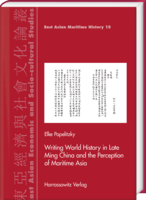|
|
more titles of the subject:
Download:
Please note: With adding digital Products to your cart
the payment will be handled via PayPal. The download will be provided after the payment is confirmed. The last century of China’s Ming dynasty (1368–1644) saw many troubles and challenges from abroad. Pirates raided the coast, Europeans challenged the traditional world order of the tribute system, and the everlasting threat from the northern steppe people continued to raise concerns for the state. This climate of uncertainty resulted in many Ming literati discussing foreign countries. During the last decades of the Ming, seven authors wrote monographs that can be considered a form of early Chinese “world history.” The authors describe the geography, the history, and the political systems of foreign countries and regions ranging from China’s close neighbors Japan and Mongolia to more distant lands such as Mogadishu and Europe.
This books by Elke Papelitzky studies each of the seven author’s knowledge and perception of the world and focuses especially on the countries connected with China at the maritime border: Siam, Malacca, and Portugal, combining a close textual and paratextual analysis with a biographical study to understand why the authors wrote the texts the way they did. This is the first comprehensive introduction to these texts contributing to an understanding of late Ming historiography as well as the perception of foreign countries by late Ming scholars. |
|||||||||||||||||||||||||||||||||||||||






